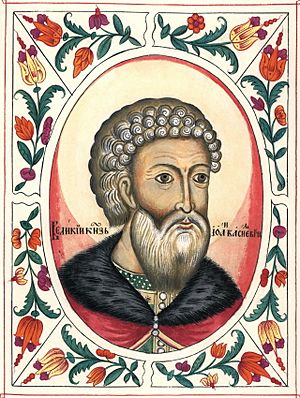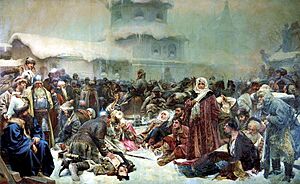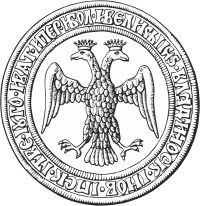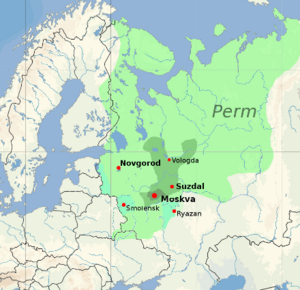Ivan III of Moscow facts for kids
Quick facts for kids Ivan III |
|
|---|---|
| Sovereign of all Rus' | |

Miniature from the Tsarskiy titulyarnik ("Tsar's Book of Titles", 1672)
|
|
| Grand Prince of Moscow | |
| Reign | 28 March 1462 – 27 October 1505 |
| Coronation | 14 April 1502 |
| Predecessor | Vasily II |
| Successor | Vasily III |
| Born | 22 January 1440 Moscow, Grand Duchy of Moscow |
| Died | 27 October 1505 (aged 65) Moscow, Grand Duchy of Moscow |
| Burial | Cathedral of the Archangel, Moscow |
| Consort |
|
| Issue more... |
|
| House | Rurik |
| Father | Vasily II of Russia |
| Mother | Maria of Borovsk |
| Religion | Russian Orthodox |
Ivan III Vasilyevich (Russian: Иван III Васильевич; born January 22, 1440 – died October 27, 1505) was a very important ruler of Russia. He was also known as Ivan the Great. He served as the Grand Prince of Moscow and the ruler of all Rus'.
Ivan started helping his blind father, Vasily II, rule in the mid-1450s. He officially became the Grand Prince in 1462. During his 43-year reign, he greatly expanded his state's territory. He also ended the long rule of the Tatars over Russia.
Ivan rebuilt the Moscow Kremlin and created a new set of laws. He laid the groundwork for a strong, united Russian state. His victory over the Great Horde in 1480, known as the Great Stand on the Ugra River, is seen as the moment Russia became truly independent. This happened 240 years after the Mongols invaded Kievan Rus'.
Ivan was the first Russian ruler to call himself "tsar" (emperor), though it wasn't his official title yet. He married Sophia Palaiologina, who was related to the last Byzantine emperor. Through this marriage, the double-headed eagle became Russia's symbol. He also adopted the idea of Moscow being the "Third Rome", meaning it was the new center of the Orthodox Christian world.
Contents
Expanding Russia's Lands
Ivan's time as ruler saw Moscow's territory grow a lot. He brought many independent areas under Moscow's direct control. This meant that local princes lost their power and land.
His first big challenge was a war with the Republic of Novgorod. Moscow and Novgorod had fought for a long time over land and power. Novgorod was worried about Moscow's growing strength. So, they tried to make a deal with Lithuania, hoping to get protection from Casimir IV, the King of Poland and Grand Prince of Lithuania. Moscow saw this as a betrayal of their shared Orthodoxy faith.
In 1470, Ivan led his army against Novgorod. His generals won two major battles in 1471. Novgorod was forced to make peace. They agreed to stop talking to Lithuania and gave up a large part of their northern lands. They also had to pay a lot of money.
Ivan visited Novgorod several times after this. He punished people who supported Lithuania and took their lands. In 1477, some Novgorod envoys called Ivan "Sovereign" instead of "Sir." Ivan took this as a sign that they accepted his full rule. When Novgorod denied this and said they would turn to Lithuania again, Ivan marched his army against them.

Novgorod was left alone by Lithuania and surrounded by Moscow's armies. On January 15, 1478, Novgorod finally agreed to Ivan's direct rule over their city and its large surrounding areas. Ivan took most of Novgorod's land. He kept half for himself and gave the rest to his supporters. Later revolts were met with harsh punishments. Many rich families were moved from Novgorod to Moscow and other cities.
Other areas were also added to Moscow's control. These included the Principality of Yaroslavl in 1463, Rostov in 1474, Tver in 1485, and Vyatka in 1489.
Ivan also had four brothers who ruled their own lands. Ivan wanted all land to pass to the main Grand Duke (himself) after a prince died, not to the prince's children. This was a new rule that helped him centralize power. He fought several wars with his brothers over this, and he always won. By the time he died, almost all these semi-independent lands were under Moscow's control.
Changes in Government

Under Ivan III, the way Moscow was governed changed a lot. It became more like an autocracy, meaning the ruler had absolute power. This happened as Moscow became the most powerful land in the region. After the fall of Constantinople (the capital of the Byzantine Empire), many believed that the Grand Princes of Moscow were the new leaders of the Orthodox Church. Ivan liked this idea and started calling himself "tsar" in letters to other countries.
This change in power also happened around the time Ivan III remarried. His first wife, Maria of Tver, died in 1467. Then, in 1469, Pope Paul II suggested Ivan marry Sophia Palaiologina. She was the niece of Constantine XI, the last Byzantine emperor. The Pope hoped this marriage would bring Russia closer to the Catholic Church. However, Sophia became an Orthodox Christian and encouraged Ivan to adopt more imperial ideas from the Byzantine Empire. Because of her, Moscow's court adopted the formal customs and the two-headed eagle symbol of Constantinople.
Ivan's son with his first wife, Ivan the Young, died in 1490. This left his grandson, Dmitry, as the next in line. Dmitry was even crowned as the future ruler in 1498. However, Ivan later changed his mind and chose Sophia's older son, Vasily, to be his co-ruler in 1502. Dmitry was put in prison and died there later.
Ivan also started to keep his distance from the boyars (powerful nobles). The old system, where boyars were consulted on state matters, disappeared. The ruler became very powerful, and the boyars became dependent on his will. The boyars did not like these changes and tried to resist them.
During Ivan III's reign, a new law code called the Sudebnik was created. Ivan also wanted Moscow to be as grand as Constantinople. So, he invited many foreign builders and artists to Moscow. The most famous was Ridolfo di Fioravante from Italy. He built several cathedrals and palaces in the Moscow Kremlin and helped build the Kremlin walls.
Dealing with Other Countries
Ivan III's reign is famous for ending the Tatar rule over Muscovy. In 1476, Ivan refused to pay the usual tribute to the Tatar leader, Khan Ahmed. In 1480, Ahmed Khan launched a military campaign against Moscow. The two armies faced each other across the Ugra River for months. Finally, on November 11, 1480, Ahmed retreated without a fight.
The next year, Khan Ahmed was attacked and killed by another Tatar leader. This caused the Golden Horde (the Tatar state) to fall apart. In 1487, Ivan made the Kazan Khanate, another Tatar state, a vassal state (meaning it was controlled by Moscow).
Ivan had peaceful relations with other Muslim powers, like the Khan of the Crimean Khanate and the Ottoman Empire. The Crimean Khan, Meñli I Giray, even helped Ivan against Lithuania. He also helped Moscow establish diplomatic ties with Constantinople.
Christian rulers in the Caucasus region saw Moscow as a natural ally against Muslim powers. King Alexander I of Kakheti from Georgia sent two groups of diplomats to Moscow in 1483 and 1491. However, Moscow was still too far away to help much. In 1488, Ivan asked King Matthias Corvinus of Hungary for help finding gun makers, cannon experts, and Italian builders.
In the north, Ivan III made an alliance with John of Denmark. He also kept in touch with Emperor Maximilian I of the Holy Roman Empire, who called him a "brother." Ivan built a strong fortress called Ivangorod on the border with Estonia. During the Russo-Swedish War, Ivan tried to conquer Vyborg from Sweden but was unsuccessful.
Moscow's power grew even more when Casimir IV died in 1492. Poland and Lithuania split again. Casimir's son, Alexander, became the ruler of Lithuania. He was weak and couldn't defend his lands from Moscow's attacks. To try and save his lands, he married Helena of Moscow, Ivan's daughter. But Ivan was determined to take as much of Lithuania as possible. So, Alexander had to fight his father-in-law in 1499. The Lithuanians were defeated in the Battle of Vedrosha in 1500. In 1503, Alexander had to give up many towns to Ivan to get peace.
Ivan's Achievements
Ivan III brought many lands in north-eastern Rus' under his control. This marked the beginning of Moscow's strong rule over Russian territory. His predecessors had already increased Moscow's land from about 600 square miles to over 15,000 square miles. Ivan III then added Moscow's old rivals, Novgorod and Tver. He created a single rule over what used to be many separate areas. These former independent areas became provinces of Moscow.
After his second marriage to Sophia Palaiologina in 1472, Ivan started using the title "Tsar and Autocrat." This was a big step in showing Moscow's growing power. Also, during Ivan's reign and his son Vasily III's reign, Moscow began to be called the "Third Rome." This idea, developed by a monk named Philotheos, meant that Moscow was the true successor to the Byzantine Empire and, before that, to Rome.
Ivan also started an impressive building program in Moscow. Italian artists and builders led this work. New buildings were put up in the Kremlin, and the Kremlin walls were made stronger with new towers and gates. In 1475, Ivan III opened Russia's first cannon factory in Moscow. This allowed Russia to start making its own cannons. Ivan died on October 27, 1505, and his son, Vasily III, became the next ruler.
Timeline of Key Events
- 1462 – Becomes Grand Prince after his father dies.
- 1463 – Adds Yaroslavl to Moscow's lands.
- 1471 – Invades Novgorod, making it a state controlled by Moscow.
- 1472 – His oldest brother, Yuri, dies without children; Ivan takes his land.
- 1474 – Buys Rostov.
- 1475 – Establishes the first Russian cannon factory in Moscow.
- 1476 – Refuses to pay tribute to Khan Ahmed of the Golden Horde.
- 1478 – Fully takes over the Republic of Novgorod.
- 1480 – The Golden Horde advances to the Ugra River but retreats. This is the last time they try to force Moscow to pay tribute.
- 1485 – Adds Tver to Moscow. He officially accepts the new title of 'Grand Prince of All Russia'.
- 1487 – The Kazan Khanate becomes a state controlled by Moscow.
- 1489 – Adds the Republic of Vyatka.
- 1492 – War with Lithuania begins.
- 1494 – The war with Lithuania ends. Moscow gains Vyazma and a large region near the Oka River.
- 1499 – Lithuania is invaded again.
- 1503 – Lithuania gives Chernigov, Starodub, Novgorod-Seversky, and sixteen other towns to Moscow, ending the war.
- 1505 – Ivan dies, and his son Vasili becomes the ruler of Muscovy.
Family Life
Ivan III had children from two marriages:
1. With Maria of Tver: * Ivan Ivanovich (Ivan the Young) (born 1458 – died 1490)
2. With Sophia Palaiologina: * Helena of Moscow (born 1476 – died 1513), who became Grand Duchess of Lithuania and Queen of Poland. * Vasily III of Russia (born 1479 – died 1533), who became the next Grand Prince of Moscow. * Yury Ivanovich (born 1480 – died 1536) * Dmitry Ivanovich (born 1481 – died 1521) * Eudoxia Ivanovna (born 1492 – died 1513) * Feodosia Ivanovna (born 1485 – died 1501) * Simeon Ivanovich (born 1487 – died 1518) * Andrey of Staritsa (born 1490 – died 1537)
See also
 In Spanish: Iván III de Rusia para niños
In Spanish: Iván III de Rusia para niños





